10 Effective SMART Goals for Managers: A Roadmap to Success
In the modern, rapidly changing business landscape, SMART goal
In the modern, rapidly changing business landscape, SMART goal setting for professionals is a key for managerial achievement. Establishing well-defined, clear and actionable goals keeps managers to track the tasks and allows teams to work together towards common objectives and organizational goals. Although most managers understand the importance of goals, effective implementation involves having the appropriate strategies, tools, and frameworks.
One of the most effective methods is the SMART professional goal setting framework which stands for Specific, Measurable, Achievable, Relevant, and Time-bound. This structured approach empowers managers to create realistic objectives aligned with their organization’s mission and vision, offering a powerful tool for business leadership.  When combined with the right goal management software, SMART goals can take on a new level of effectiveness. With real-time tracking, collaboration tools, and data-driven insights, modern goal-setting platforms allow managers to monitor progress, make data-informed decisions, and keep their teams engaged.
When combined with the right goal management software, SMART goals can take on a new level of effectiveness. With real-time tracking, collaboration tools, and data-driven insights, modern goal-setting platforms allow managers to monitor progress, make data-informed decisions, and keep their teams engaged.
Here, we’ll explore ten crucial SMART Professional goals every manager should implement, using the SMART professional goal setting framework as our foundation. You’ll also discover modern tools that enhance tracking capabilities and review practical OKR examples to guide your team toward success.
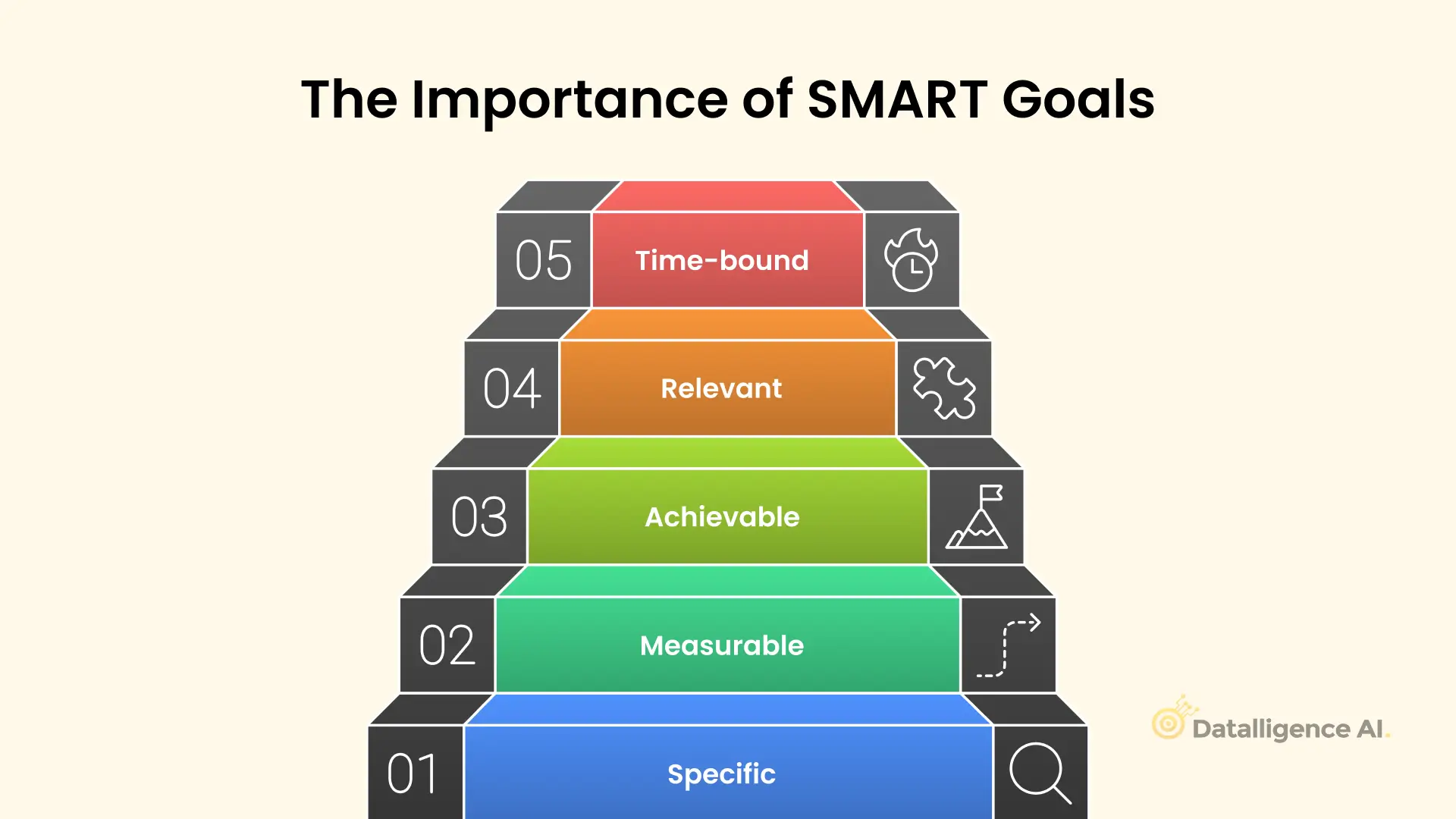 Before discussing particular examples, here's why the SMART framework for professional goal setting continues to be one of the most useful management strategies:
Before discussing particular examples, here's why the SMART framework for professional goal setting continues to be one of the most useful management strategies:
Used consistently, SMART goal setting instills alignment, clarity, and accountability—making it a staple of any high-performing manager's arsenal.
One of the top priorities for any manager is staff development. When constructed with the SMART professional goal setting process, performance objectives become more actionable and quantifiable.
Goal: Increase team performance metrics by 25% within 6 months through regular one-on-one meetings and leveraging performance tracking software.
This goal can be broken down into specific OKRs (Objectives and Key Results)
Objective: Improve team performance through consistent feedback and development.
To achieve this goal, managers should use performance management software that offers real-time monitoring of key performance indicators (KPIs) and allows for performance reviews and feedback. Tools that track individual contributions and team metrics can help identify strengths and areas for improvement, ensuring that the team is on track to meet its performance targets. Moreover, software that schedules and tracks one-on-one meetings can make the process more structured, ensuring that every team member receives the necessary support and feedback. With documented meetings, managers can provide actionable insights, track progress over time, and keep employees engaged and accountable for their goals.
For most organizations, revenue growth is a key indicator of success. As a manager, setting a revenue-related SMART goal is crucial to ensure that the team is focused on driving sales and increasing business outcomes.
Goal: Achieve a 30% increase in quarterly revenue through effective sales strategies and pipeline management. This goal can be translated into OKRs as follows:
Objective: Drive revenue growth by optimizing sales strategies and performance.
Revenue growth requires not just increasing sales but also optimizing sales processes, refining strategies, and ensuring that the sales team is properly equipped. Sales forecasting and pipeline management software can help track these OKRs by offering real-time insights into sales performance and customer acquisition trends. With modern software, managers can monitor the performance of each salesperson, track their progress against set sales targets, and adjust strategies as needed. Additionally, these platforms allow managers to identify underperforming areas in the sales process, enabling them to provide coaching and resources where necessary. Having a clear, measurable goal like this helps focus the team’s efforts and aligns them with broader organizational objectives.
In today’s competitive business environment, customer satisfaction is paramount. Satisfied customers are more likely to become repeat buyers, refer others, and increase revenue. As a manager, focusing on customer satisfaction is essential for long-term success.
Goal: Increase customer satisfaction from 85% to 95% within 4 months through proactive feedback gathering and issue resolution. This goal can be broken down into OKRs:
Objective: Enhance customer satisfaction by improving service quality and responsiveness.
To achieve these OKRs, managers should leverage customer feedback software that enables them to track satisfaction levels, gather real-time feedback, and identify trends in customer sentiment. These platforms allow managers to monitor how well the team is handling customer issues, ensuring that complaints are resolved quickly and effectively. By using a customer satisfaction platform, managers can receive alerts when customer issues arise, helping them respond promptly. Furthermore, the platform can provide insights into areas where improvements are needed, helping managers develop targeted strategies to boost satisfaction. Ensuring that the team responds to customer concerns quickly and effectively is key to meeting the desired satisfaction scores. 
Efficient budget management is an ongoing responsibility for any manager, particularly in a fast-moving business environment where resources need to be allocated efficiently. A SMART goal focused on cost reduction and financial discipline is essential for maintaining profitability.
Goal: Reduce departmental operating costs by 15% over 6 months through efficient expense tracking and resource optimization. This goal can be translated into the following OKRs:
Objective: Improve financial efficiency by reducing operating costs and optimizing resource allocation.
Expense management software is vital for managers aiming to reduce costs while maintaining the quality of service. These tools allow for detailed tracking of expenses, providing managers with real-time data to identify areas where spending can be minimized. Automated reports simplify the review process, allowing for quicker identification of unnecessary costs and enabling managers to make adjustments on the fly. By setting clear cost reduction targets and monitoring spending using software, managers can ensure that they stay within budget while driving operational efficiency.
Productivity is one of the most important metrics for any team. Enhancing productivity leads to higher efficiency, improved team morale, and better overall results. Managers need to set clear, actionable goals for improving productivity.
Goal: Boost team productivity by 40% within 3 months through better task management and workflow optimization. This goal can be broken down into OKRs:
Objective: Increase team productivity by optimizing processes and eliminating bottlenecks.
Project management software can help track tasks, streamline workflows, and monitor productivity in real-time. These tools provide a centralized platform for managing projects, ensuring that team members are aligned with their tasks and deadlines. Features like time tracking, task prioritization, and collaboration tools make it easier for managers to identify productivity bottlenecks and adjust processes to improve team efficiency.
When there are to-do lists galore, back-to-back meetings, and priorities that change daily, it is simple for teams to lose focus on what counts. That's where OKRs — Objectives and Key Results — come in like a superhero of goal-setting. From Silicon Valley's birth to Google, LinkedIn, and Spotify's adoption, OKRs have revolutionized how businesses set and slay goals. What's behind OKR's strength as a goal-setting framework? Let's dive in.
OKR is an abbreviation for Objectives and Key Results. Consider this:
OKR = Objectives + Key Results
Objective = What you aim to do. It must be bold, concise, and motivating.
Key Results = How you will track progress towards that goal? These are specific, time-sensitive, and quantifiable.
For instance:
Objective: Be the best-rated customer support group in the industry.
Key Results:
Reach 95% customer satisfaction rate.
Cut the average response time to less than 2 minutes.
Close to 90% of problems in the first contact.
This approach turns large aspirations into a game plan — with scorecards.
Old goal-setting has a tendency to center around generic aspirations: "Do better," "Sell more," or "Improve quality." These goals are fine-sounding, but they are too open to interpretation. More significantly, they don't provide teams with a clear definition of how success will be measured.
Enter OKRs. They remove the fluff from goal-setting and substitute focus, alignment, and accountability.
Focus That Cuts Through the Noise
OKRs make you prioritize. Teams usually set only 3–5 objectives per quarter, with 2–4 key results each. Having a finite number guarantees you're not working on everything — just the most important things. The payoff? Less busywork, more impact.
Alignment That Gets Everyone Moving in the Same Direction
One of the strongest features of OKRs is the way that they cascade through an organization. When a firm establishes high-level OKRs, departments and individuals can develop their own OKRs that align with the upper-level goals. This establishes transparency and unity — everyone has something they're working for and why.
Measurability That Builds Accountability
Key Results are quantifiable. You're either meeting them or you're not. This precision removes ambiguity and makes it easy to monitor progress over time. No more wondering if you're "doing great" — the numbers talk.
Agility in a Fast-Changing World
OKRs are usually established on a quarterly basis, keeping organizations nimble. You're not committed to a year's worth of planning that can render the plan useless next month. OKRs provide you with the agility to make corrections while still targeting bold outcomes.
OKRs aren't magic, but they come close when implemented well. They establish a cycle of goal-setting that combines ambition and structure, and creativity and clarity. If you're leading a startup, or a part of a huge enterprise, OKRs can redefine the way you work — from chaos to clarity.
Next time you're setting goals, avoid the woolly resolutions. Opt for OKRs, and empower your goals to actually deliver. Book your FREE DEMO today!
The journey toward achieving these SMART goals becomes more manageable with the right goal-setting software. These platforms offer essential features like goal tracking, performance analytics, collaboration tools, and automated reporting. When selecting a solution, consider factors such as mobile accessibility, real-time updates, and integration capabilities with existing systems. Success in implementing these goals requires consistent monitoring and adjustment. Regular review sessions, supported by software analytics, help maintain momentum while identifying areas for improvement. Team engagement plays a crucial role, with transparent progress sharing and milestone celebrations helping maintain motivation and focus.
Setting and achieving SMART goals is a fundamental aspect of managerial success. By leveraging modern goal-setting software and following a structured approach to implementation, managers can create clear pathways to success while maintaining accountability and tracking progress effectively. SMART goals, when paired with powerful SMART goal setting tool, offer managers the opportunity to streamline their operations.
Admin DAI2025-06-26T22:46:12+00:00June 26, 2025|Objectives and Key Results|
In the modern, rapidly changing business landscape, SMART goal
Admin DAI2025-06-19T12:37:29+00:00June 18, 2025|Employee Engagement|
Do you know a highly Engaged Workforce Increases Profitability by
Admin DAI2025-06-19T12:43:48+00:00June 11, 2025|OKR Examples|
In today's rapidly evolving business landscape, effective leadership is
Admin DAI2025-06-10T10:04:12+00:00June 9, 2025|General, Objectives and Key Results|
As a business owner, growth is the important metric
Admin DAI2025-06-10T11:12:51+00:00June 9, 2025|General|
It is essential for the ever-changing field of human
Admin DAI2025-05-26T05:18:39+00:00May 22, 2025|Performance Management|
Employee performance management software is no longer a nice-to-have,
Admin DAI2025-05-25T08:16:50+00:00May 22, 2025|Objectives and Key Results|
Are you looking for the perfect performance management software to
Admin DAI2025-05-22T04:47:37+00:00May 21, 2025|Objectives and Key Results|
Understanding OKR SpreadsheetsIf you’re seeking an OKR spreadsheet template, you
Admin DAI2025-05-20T09:58:57+00:00May 19, 2025|Objectives and Key Results|
Setting SMART goals is firmly integrated with the OKR framework,
Admin DAI2025-06-19T12:23:06+00:00May 17, 2025|Objectives and Key Results|
In today's fast-paced business landscape, effective goal-setting and goal
In today's fast-paced business landscape, effective goal-setting and goal alignment are critical factors for success. That's where OKR management comes into play. Objectives and Key Results (OKR) is a goal-setting framework that helps organizations set ambitious objectives and measurable key results to drive performance and accountability. To make the OKR process seamless and efficient, there are several Best OKR management tools for 2025 available in the market.
In this comprehensive guide, we will explore the top 7 Best OKR management tools for 2025. We will delve into their features, pros, and cons, enabling you to make an informed decision about which tool best suits your organization's needs. Whether you're a small startup or a large enterprise, these tools can provide the necessary framework to enhance goal alignment, track progress, and foster transparency across your organization.
OKR management involves the process of setting, tracking, and managing objectives and key results using specialized software. Best OKR management tools for 2025 enable organizations to define ambitious goals, align teams, track progress, and measure success. These tools provide features such as goal-setting templates, progress-tracking dashboards, collaboration tools, and analytics and reporting capabilities.
Implementing Best OKR management tools for 2025 offers several benefits for organizations:
Now, let's delve into the Best OKR management tools for 2025.
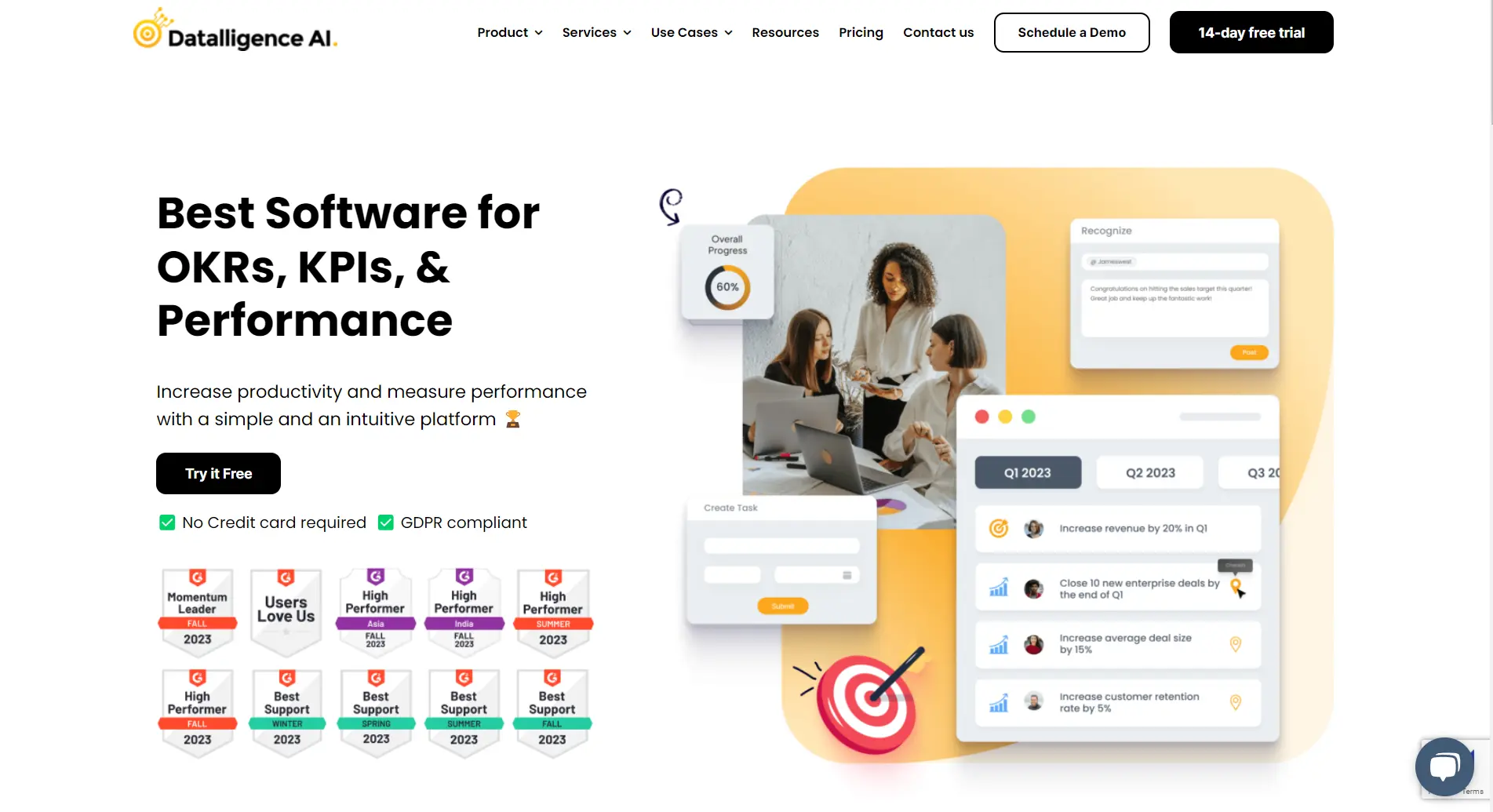
Datalligence emerges as a game-changer in the realm of performance management, providing organizations with a robust platform designed to elevate goal-setting and achievement. With a user-friendly interface and advanced features, Datalligence stands out as a top-tier Best OKR management tools for 2025. Whether you're an individual looking to set ambitious personal goals or a business aiming to align company objectives, Datalligence offers a tailored solution that goes beyond traditional performance metrics.
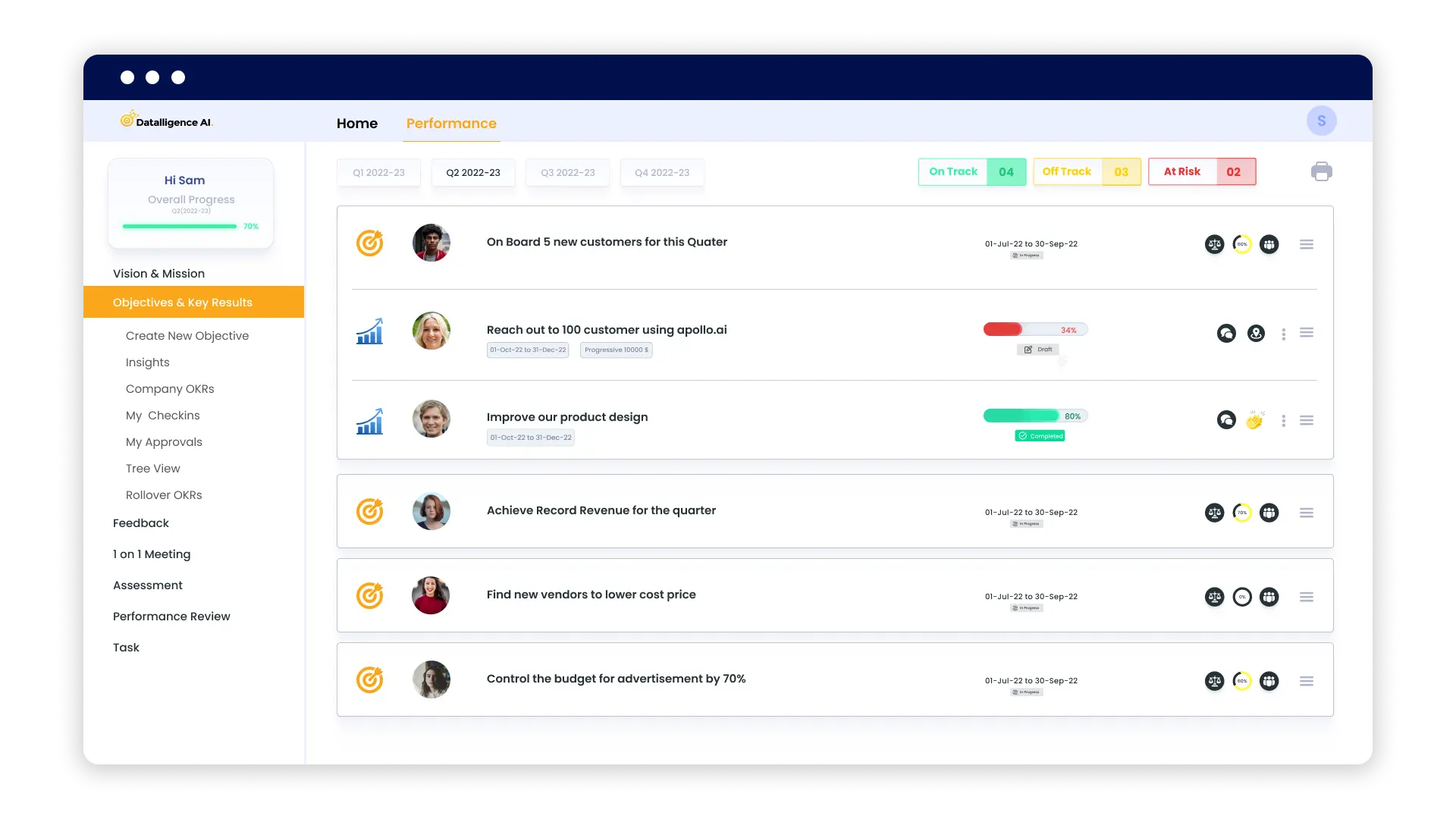
Datalligence simplifies the goal-setting process with an intuitive interface, allowing users to effortlessly define and modify objectives and key results. The platform's flexibility accommodates both personal and organizational goals, ensuring a tailored experience that aligns with diverse business needs.
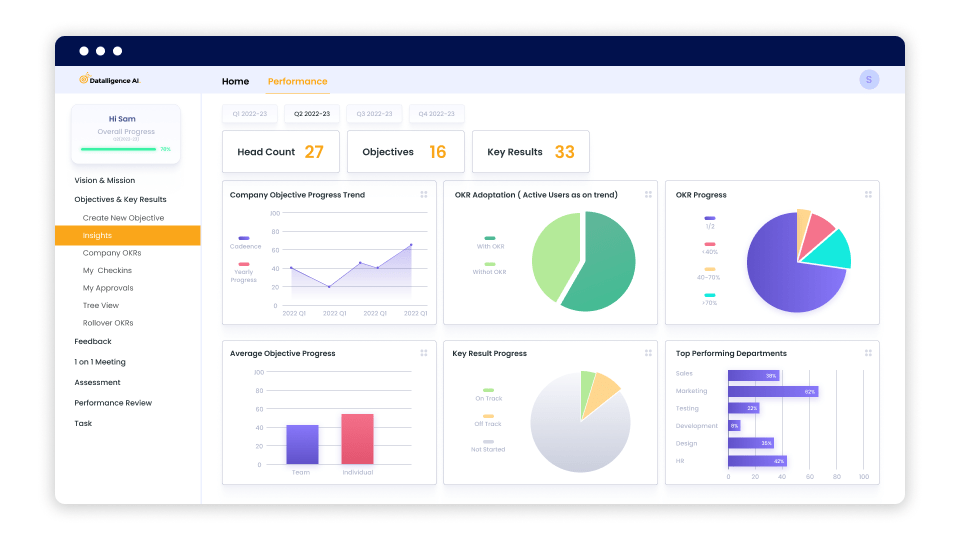
The robust analytics and customizable reports provided by Datalligence offer a visual representation of performance. This feature goes beyond mere tracking, allowing organizations to delve into trends and patterns, facilitating in-depth analysis. These insights empower data-driven decision-making, enabling continuous improvement and optimization of goal-setting processes.

The platform promotes regular communication and accountability through automated check-ins. These scheduled updates streamline communication, ensuring that team members stay informed about goal progress and are prompted to provide updates without additional manual effort.
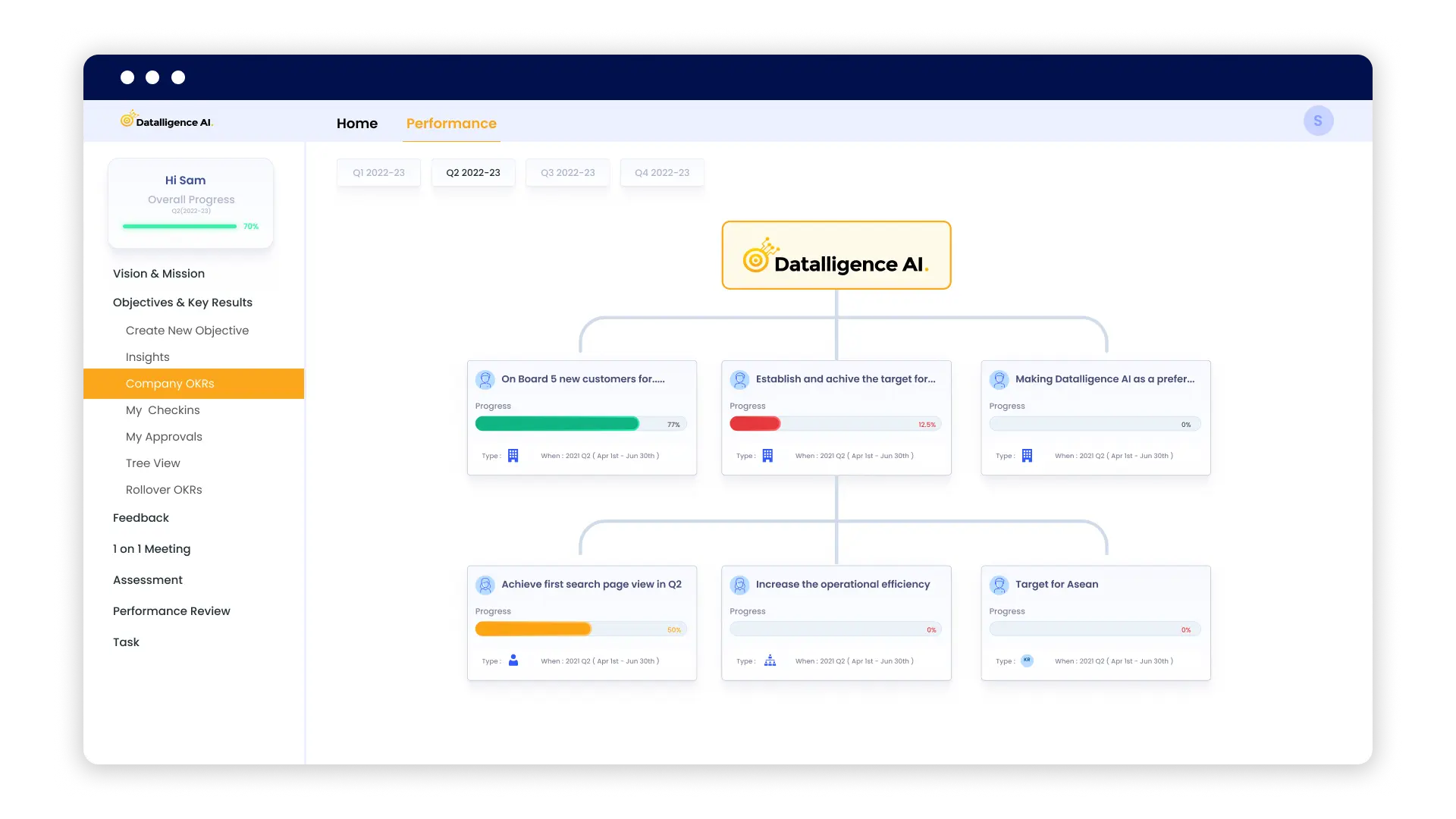
Datalligence facilitates a seamless alignment of individual and team goals with broader organizational objectives through goal cascade. This ensures that every level of the organization is working cohesively towards overarching strategic priorities, fostering a unified approach to success.
OKR Retrospective offers a detailed historical account of goal changes, creating a comprehensive audit trail. This feature ensures that every modification and evolution of objectives is meticulously documented.
To accommodate diverse organizational processes, Datalligence offers a customizable workflow. This feature allows users to adapt the platform to their unique processes and requirements, ensuring that the tool integrates seamlessly with existing workflows and methodologies.
A standout feature of Datalligence is its comprehensive progress-tracking system. Providing real-time updates and insights, this functionality enables teams to monitor the status of key results and overall goal achievement. The dynamic tracking capabilities empower organizations to make informed decisions and adapt strategies promptly.
Collaboration is further encouraged through discussion threads within the platform. This feature allows team members to communicate, share insights, and provide feedback directly within the context of specific goals, fostering a collaborative environment.
Datalligence keeps users on track by sending automated reminders for upcoming deadlines and check-ins. This feature minimizes the risk of oversights, ensuring that teams stay proactive in meeting their goals and maintaining accountability.
Datalligence offers a free plan for all its users up to 14 days. The basic Goals and OKRs plan starts at $4 per user/month, and the recommended plan for all users is the Performance+ plan, which starts at $6 per user/month. For more information about the plan or about the enterprise plan, contact our sales team.
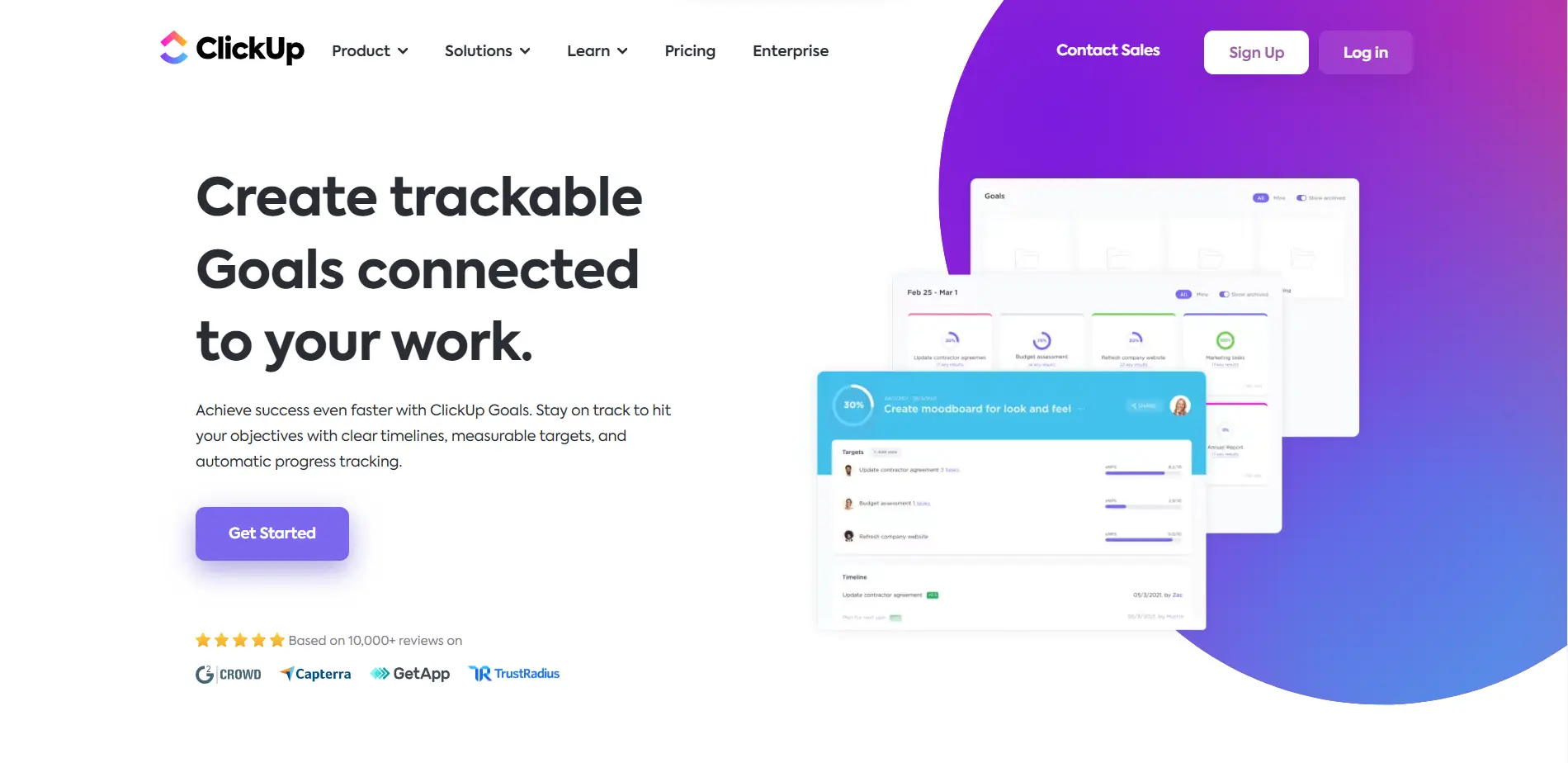
ClickUp's Goals feature allows you to set and edit objectives and key results with ease. You can create personal OKRs or align your goals with your company's objectives. The intuitive interface lets you customize your goals by setting names, due dates, responsible team members, and access permissions. You can also break down your goals into measurable targets (key results) and track progress for each target.
ClickUp provides a comprehensive progress tracking system for key results and goals. You can easily track the progress of each target and measure how your targets contribute to your overall goal achievement. The platform offers real-time updates and insights, allowing you to make data-driven decisions and adjust strategies as needed.
With ClickUp's Goals Folders feature, you can efficiently organize and group your goals. You can create folders for weekly, monthly, and yearly goals, ensuring that your objectives are well-structured and easily accessible. Making folders public promotes transparency and enables individuals and teams to understand how their goals align with the overall business objectives.
ClickUp's Weekly Scorecards feature enables teams to break down goals into smaller tasks that can be accomplished during the week. This promotes collaboration, accountability, and motivation among team members. The scorecards visually represent progress, allowing teams to track their contributions to company OKRs effectively.
ClickUp's Dashboards feature empowers you to plan, track, and assess progress through completed tasks and time tracked on projects. With customizable widgets, you can gain detailed insights into tasks, sprints, people, and projects. The intuitive Gantt Chart feature visualizes tasks and progress, while task dependencies ensure that teams complete tasks in the correct order.
The basic plan starts from $7 per user/month and for more information, Contact the Clickup sales team.
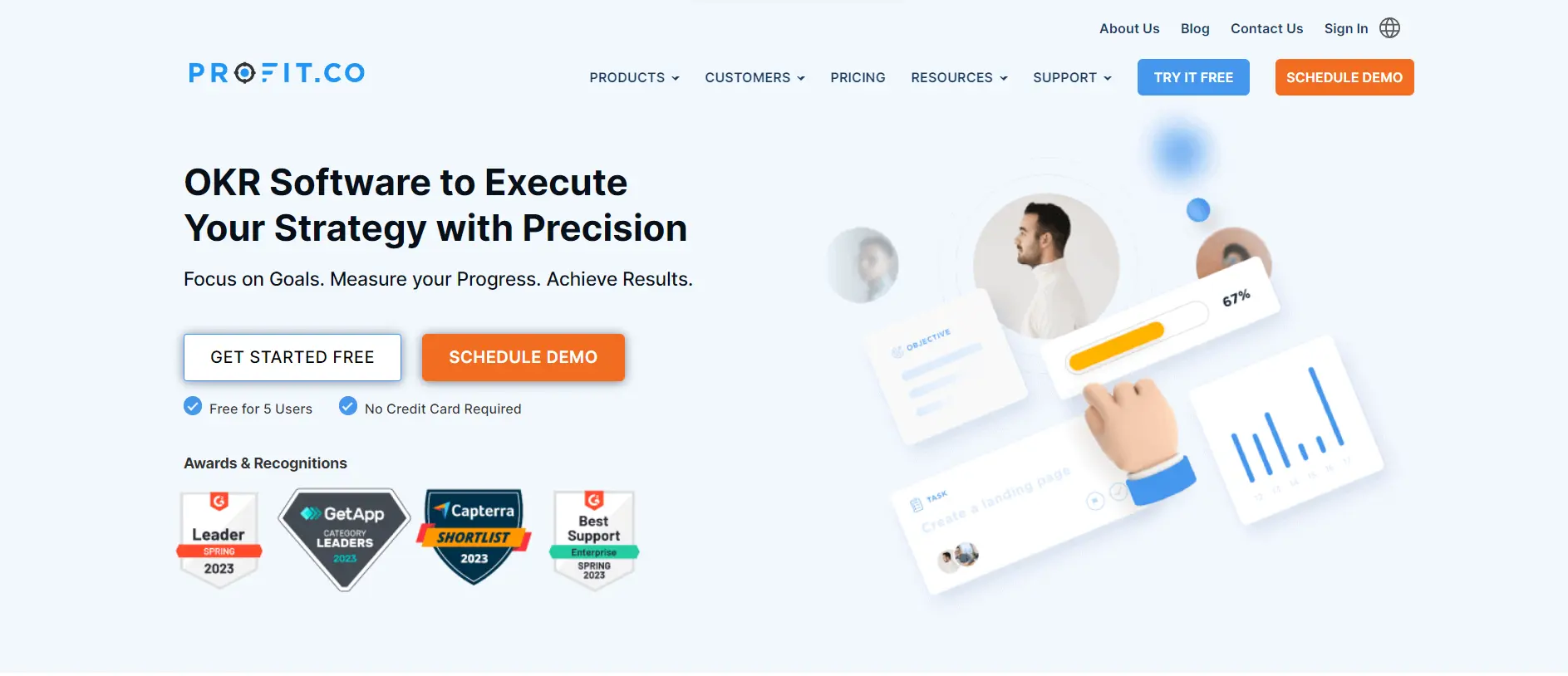
Profit. co is a popular OKR software that helps organizations prioritize goals, assess progress, and achieve better outcomes. With its comprehensive features and user-friendly interface, Profit. co is an excellent choice for companies looking to align their objectives and drive performance.
Profit. co's alignment dashboards provide a holistic view of your company's vision and goals. These dashboards enable the entire organization to understand and contribute to top-level objectives. With 400+ inbuilt and custom KPIs, you can efficiently measure performance and ensure that teams are aligned with the company's strategic direction.
Profit. co offers performance review tools that link OKRs to employee performance evaluations. This integration allows managers to assess individual contributions to OKRs and provide feedback accordingly. The platform also helps identify and eliminate bottlenecks through real-time heatmaps, ensuring that teams stay on track and focused on achieving their goals.
Profit. co provides extensive customization options for OKRs. You can define values, properties, and details to align with your specific goals and objectives. The software also offers OKR templates and best practice guidance to help you create effective OKRs and achieve better outcomes.
Contact Profit. co sales team for more information.

Aha! is a goal-setting software that helps cross-functional teams capture ideas, set schedules, and track progress. While not specifically designed as an OKR tool, Aha! offers features that can effectively support OKR implementation and goal management.
Aha! allows you to create strategic roadmaps that establish clear OKR goals with measurable results. You can define objectives and key results and set timelines to track progress. The software's customizable workflows enable teams to work in a way that aligns with their processes, ensuring efficient goal achievement.
Aha! provides custom workflows that allow teams to adapt the software to their specific needs. You can define your own processes, collaborate on tasks, and ensure that your team's work aligns with the overall business objectives. The software also offers real-time document editing for seamless collaboration and idea sharing.
Aha! enables you to visualize progress through roadmaps and reports in real time. These visual tools provide a clear overview of goal achievement and help identify areas that need improvement. Real-time document editing allows teams to collaborate on ideas and goals, fostering a culture of continuous improvement and innovation.
Aha! plan starts at $59/user per month and for more information, contact their sales team.

Weekdone is an OKR software that focuses on setting structured goals with measurable outcomes. It offers features that enhance team collaboration, track progress, and improve overall performance.
Weekdone enables you to set clear and measurable objectives for your team. You can define key results and assign responsibilities to team members. The platform's one-on-one meetings feature helps improve employee performance, while feedback and recognition support boost morale and progress.
Weekdone's weekly check-ins feature allows teams to track their weekly activities and ensure that they align with company OKRs. This fosters collaboration and visibility, promoting a sense of interconnectedness among team members. The platform's goal hierarchy feature visualizes significant company goals, allowing teams to contribute effectively.
Weekdone offers dashboards and reporting features that provide insights into goal progress and team performance. You can view trend reports, measure changes in performance, and identify areas for improvement. The platform's private notes feature allows you to jot down personal reminders and ideas for continuous improvement.
Contact the Weekdone Sales team for more information.

Businessmap is a Lean and Agile platform that visualizes objectives and key results on interconnected Kanban boards. It provides comprehensive customization options and promotes transparency and progress tracking.
Businessmap offers extensive customization options for OKRs, allowing you to define values, properties, and details based on your specific goals. You can customize key results filtering and use colored indicators to track progress. The platform also provides automatic projections to ensure accurate goal tracking.
Businessmap's goal maps feature aligns strategy and execution through transparent and interconnected Kanban boards. This visual representation helps teams understand how their work contributes to overall business objectives. The platform also allows for the measurement of actual versus expected progress on OKRs.
Businessmap facilitates collaboration and visualization, enabling teams to work together effectively. The platform's visualization tools help teams understand cross-team dependencies and track progress in one place. This fosters transparency, accountability, and alignment across objectives, projects, and work items.
Contact the Businessmap Sales team for more information
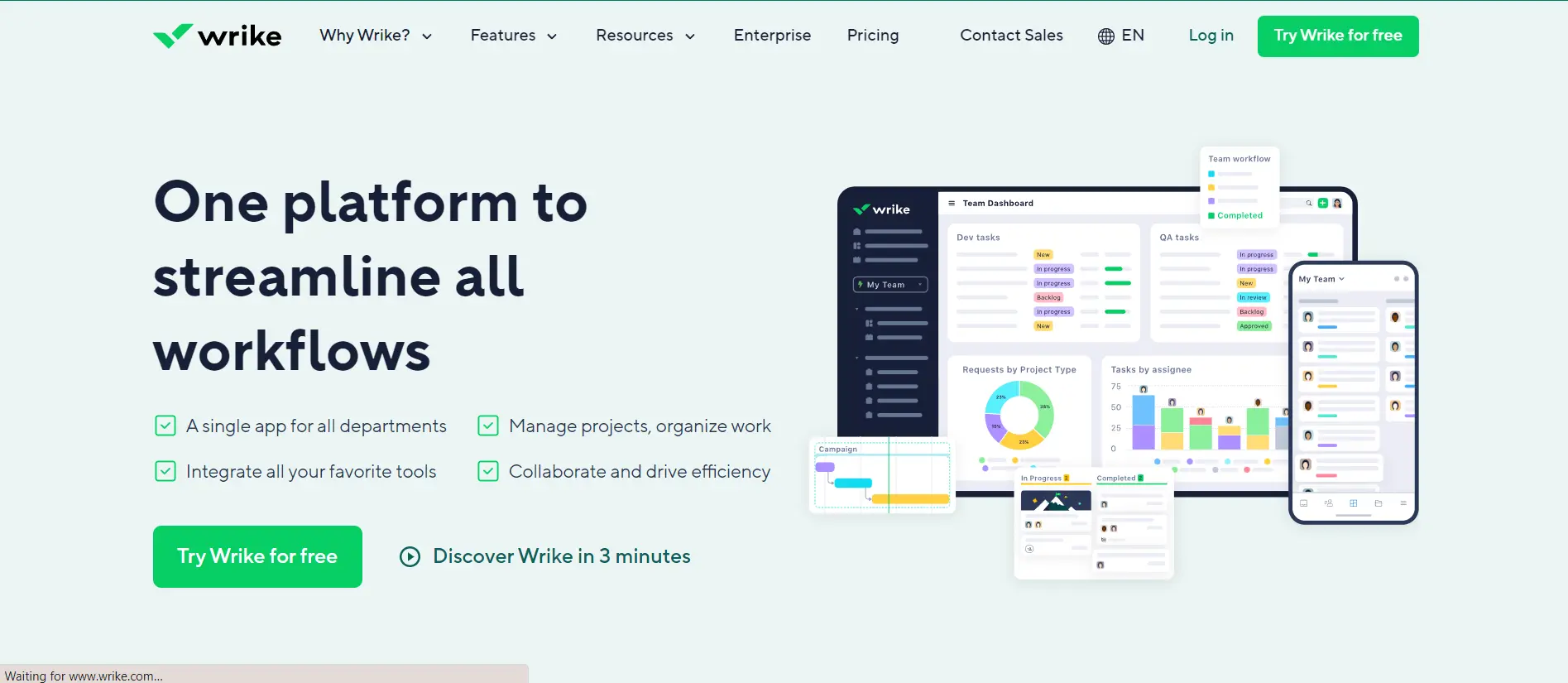
Wrike is primarily a project management software that also serves as an effective OKR management tool. Its features enable goal alignment, progress tracking, and improved team performance.
Wrike allows you to create projects and tasks that define objectives and key results. You can set due dates, assign tasks to team members, and align them with the company's overall vision. The software provides a range of tools to track progress, including task lists, progress reports, and dashboards.
Wrike's performance management features link OKR progress to employee evaluations. This integration helps managers assess individual contributions and provide feedback accordingly. The platform's resource management feature enables efficient allocation of resources, ensuring that teams have the necessary support to achieve their goals.
Wrike facilitates collaboration and transparency among team members. Integration with popular workplace tools like Slack and Microsoft Teams streamlines communication and promotes seamless collaboration. The software's customization options, including task statuses and workflows, allow teams to adapt Wrike to their specific needs.
Wrike basic team plan starts at $9.80 per user per month, their business plan starts from $24.80 per user/month and for more information, contact their sales team.
OKR management software plays a crucial role in enhancing goal alignment and driving performance across organizations. The top 7 OKR management tools and software for 2025, including ClickUp, Profit.co, Aha!, Weekdone, Businessmap, and Wrike, offer a wide range of features to support your goal-setting and tracking needs. Each tool has its strengths and weaknesses, so it's important to evaluate them based on your organization's specific requirements.
By implementing an OKR management tool, you can streamline goal-setting, foster transparency, and align individual and team objectives with your company's strategic goals. Whether you're a small startup or a large enterprise, these tools can empower your organization to achieve better outcomes and drive success.
At Datalligence AI, we understand the importance of effective OKR management. Our data-driven solutions can help you implement and optimize OKR processes, ensuring that your organization maximizes goal alignment and performance. Contact us today to learn how our expertise can transform your OKR management journey.